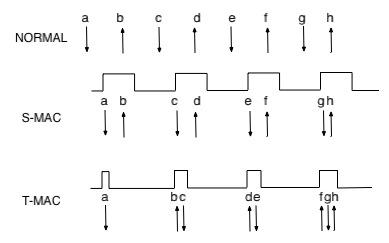T-MAC
T-MAC, short for Timeout MAC, is a protocol that tries to improve the previous S-MAC by having duty cycles of different lengths. The idea is to send messages in bursts at the beginning of each duty cycle and go back to sleep mode as soon as there are no more messages to be sent or received. Nodes wait for a short period

The protocols is quite similar to S-MAC, the only difference is that it "goes to sleep" earlier, as soon as it detects there are no more communication to be done. The synchronization, RTS-CTS and acknowledgment schemes are all similar to S-MAC. The picture above shows a comparison between S-MAC and T-MAC. T-MAC saves energy by sleeping for larger amounts of time than S-MAC.
A problem has been identified in this protocol on multihop networks. It is called the "early sleeping" problem and happens when there is contention. Suppose four nodes, A, B, C and D in a multihop network. Suppose A is sending a message to B and C needs to send a message to D, but is on the communication range of B. In that case, C cannot send a RTS to D otherwise it will cause a collision in B. Since D is out of the range of both A and B, it detects no activity and goes to sleep even though C has a message for it. The same problem can happen again in the next duty cycle, whenever A or B gains access to the channel before C. The T-MAC developers provide some solutions to the problem, but even with such solutions, the maximum throughput of the protocol is compromised, when compared to S-MAC's maximum throughput.